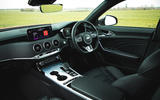What is it?
Were you to list the unexpected four-wheeled gems we’ve been given over the past few years, some names would spill freely from your mind. The Alpine A110 first, probably followed by the Toyota GR Yaris. After that, possibly the Ariel Atom 4, which we always knew was going to be epic fun but could never have predicted just how well executed the Somerset Exocet would turn out to be at the fourth (well, fifth) time of asking.
Your memory might flail around after that, but eventually it would recall the Kia Stinger GT S. What a nice surprise that was. When it arrived in 2017, this was nothing less than the first rear-driven car Kia had ever sold in this country, and it broke that duck in style.
An elegant four-door fastback in the manner of the BMW 4 Series Gran Coupé and Audi S5 Sportback, albeit marginally larger than either in footprint, the GT S had a 3.3-litre twin-turbo V6 that made 365bhp and delivered it to the rear wheels through the standard-fit mechanical limited-slip differential. It accelerated to 62mph in comfortably under five seconds, it could hit almost 170mph flat out, and the dynamic characteristics had been signed off by renowned engineer Albert Biermann, fresh from three decades at the helm of BMW M. You could also buy one and have change from £41,000, which made it exceptional value for money, for those sagacious enough to put badge-snobbery to one side.
More than anything else, the GT S served as the one thing Kia had never really had: a true halo model. It’s why, despite only modest demand over the past four years, the car, still of distinctly old-school flavour, has been updated for 2021 and will stay on sale for years yet, albeit now as a stand-alone model. Kia has dropped the 2.0-litre turbo petrol and 2.2-litre diesel engines of the more sedate GT-Line Stingers. And on a similar note, while the full-bore GT S employs all-wheel drive in LHD markets, over here it remains rear driveshafts only, for reasons relating to packaging.
The updates are subtle. Most obvious is the new light bar connecting the tail-lights. The four exhaust tips are now larger, too, and Kia has restyled the diffuser. Elsewhere, the standard-fit red Brembo brake calipers now peek out from behind a new design of 19in wheel, and the LED headlights have also been tweaked. However, while the air curtains at the edges of the front bumpers and the gills slightly aft of the front wheel arches remain functional, the nostril vents in the long bonnet are still purely cosmetic. The Stinger also retains its unusual coppery-chrome trim.
As for the mechanicals, the 3.3-litre motor is actually less powerful than before, although really this emissions-related change came about before the facelift, and at 4bhp, the deficit is minimal in the context of something that weighs 1855kg.
Yes, it’s still a big old beast, the GT S, and only 10kg lighter than a BMW M5 Competition. Elsewhere, the adaptive dampers have been retuned to be a little more forgiving across the board, but at the same time Kia claims to have achieved a “slight reduction” in understeer. That could be the result of geometry changes, or damping response, but I’d wager it’s mostly down to the most significant chassis tweak of all: the switching of Continental’s Sport Contact 5 tyres for a set of Michelin Pilot Sport 4S.










































Join the debate
Add your comment
This has to be the very definition of a fabulous car you'd never buy new or - to a lesser extent - used. Such a shame for I adore its looks and the way it drives and I'd be proud to drive it without a care about the badge. What stops me I fear is that I don't know its "story" beyond the BMW's Albert Biermann having a hand in it which intrigues me. To me, things like this give the car a depth of character that seem important in a specialist car like this. But hey, maybe I'm overthinking it and it's just the badge - what a shame. I really like this car but what can Kia do to lure buyers?